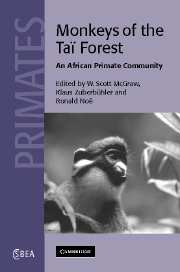Book contents
- Frontmatter
- Contents
- List of Contributors
- Preface
- 1 The monkeys of the Taï forest: an introduction
- Part I Social behavior
- Part II Anti-predation strategies
- 5 Interaction between leopard and monkeys
- 6 Interactions between red colobus monkeys and chimpanzees
- 7 Interactions between African crowned eagles and their prey community
- 8 Monkey alarm calls
- Part III Habitat use
- Part IV Conservation
- Appendix
- Index
- Plate section
- References
6 - Interactions between red colobus monkeys and chimpanzees
Published online by Cambridge University Press: 30 July 2009
- Frontmatter
- Contents
- List of Contributors
- Preface
- 1 The monkeys of the Taï forest: an introduction
- Part I Social behavior
- Part II Anti-predation strategies
- 5 Interaction between leopard and monkeys
- 6 Interactions between red colobus monkeys and chimpanzees
- 7 Interactions between African crowned eagles and their prey community
- 8 Monkey alarm calls
- Part III Habitat use
- Part IV Conservation
- Appendix
- Index
- Plate section
- References
Summary
The question how red colobus monkeys try to avoid predation by chimpanzees was central from the start of the Taï monkey project. Boesch and Boesch (1989) had documented the hunting behavior of Taï chimpanzees and their prey spectrum. Their major results were that Taï chimpanzees: (1) hunt in a very cooperative coordinated way in which individuals play different roles, i.e. a “chaser” tries to chase monkeys out of their hiding trees into neighboring trees where “blockers” try to block the escape routes; (2) often decide to hunt before they have singled out a group of monkeys for attack and actively search for groups; (3) stalk monkey groups silently and only start screaming after being detected, probably to increase confusion; (4) mainly hunt red colobus and black and white colobus monkeys, while guenons and non-primate species are rarely caught; (5) hunt all age/sex classes of red colobus. Studying the anti-predation behavior of Taï red colobus thus offered a wonderful opportunity to study a predator-prey system where both predator and prey are primates that live in large permanent individualized social groups supposedly selecting for an enlargement of the neocortex (Dunbar 1992; note that data on red colobus neocortex size are lacking). We therefore hoped that the complexity of Taï chimpanzee hunting behavior reflected adaptations (genetic or learned) to complex red colobus counter adaptations (genetic or learned).
- Type
- Chapter
- Information
- Monkeys of the Taï ForestAn African Primate Community, pp. 155 - 170Publisher: Cambridge University PressPrint publication year: 2007
References
- 1
- Cited by



